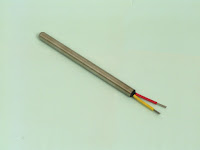 |
| Diagram of a thermocouple circuit. |
 |
| Typical sheathed thermocouple. |
Because of their wide range of models and technical specifications, it is extremely important to understand their basic structure, functionality and range in order to better determine the right thermocouple type and material for an application.
Operating Principle
When two wires consisting of different metals are connected at both ends and one end is heated, a continuous current flows through the thermoelectric circuit. If this circuit is broken in the center, the net open circuit voltage (Seebeck Effect) depends on the temperature of the junction and the composition of the two metals. This means that a voltage is produced when the connection of the two metals is heated or cooled that can be correlated to the temperature.
Contact Duro-Sense Corporation with any questions about applying industrial and commercial thermocouples.
Duro-Sense Corporation
https://duro-sense.com
310-533-6877